Nature, Water, and Play: Best Summer Activities for Kids
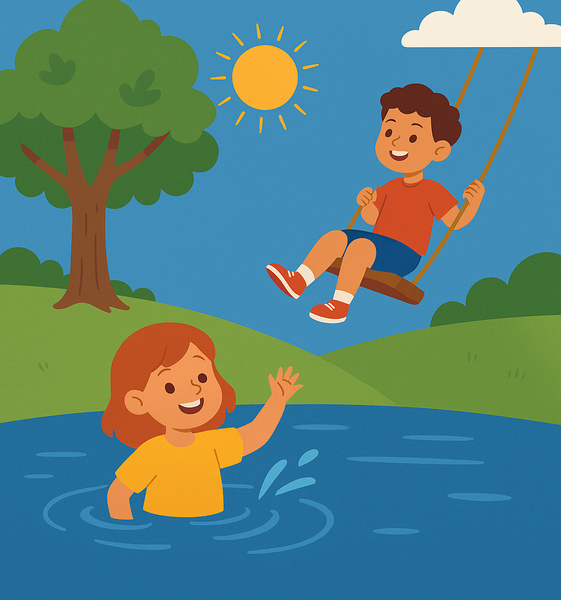
Discover fun and enriching summer activities for children that involve nature, water, and play. Boost your child's development with outdoor adventures, creative games, and refreshing water fun.
Introductionn
Summer unfurls like a bright, sunny invitation – a golden opportunity for children to explore, learn, and grow in ways that only the great outdoors can offer. The combination of nature, water, and unstructured play isn't just a recipe for fun; it's a powerful trio that fuels development, builds resilience, and creates cherished family memories. This season, let's dive into why these elements are summer essentials and discover a treasure trove of activities that will have your little ones thriving.
Section 1: The Unbeatable Trio: Why Nature, Water, and Play are Summer Essentials for Kids
Before we jump into the "what" of summer activities, it's inspiring to understand the "why." The science is clear: engaging with the natural world, splashing in water, and simply playing freely offers profound benefits for a child's developing body and mind.
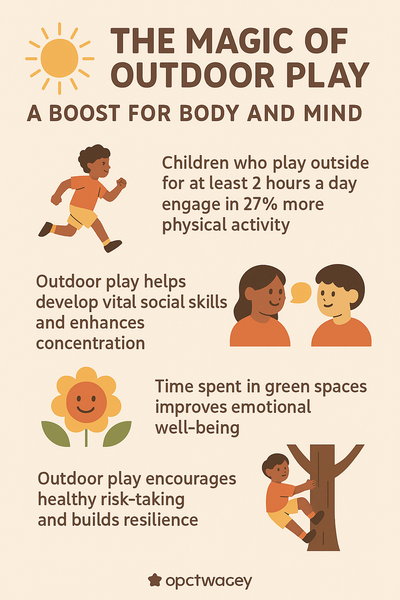
- A. The Magic of Outdoor Play: A Boost for Body and Mind
The call of the outdoors is a call to health and happiness. When children play outside, they are typically more physically active than when indoors, a crucial factor for robust cardiovascular health and a strong antidote to increasingly sedentary lifestyles. Indeed, one study highlighted that children who spent a minimum of two hours playing outside each day engaged in 27 percent more moderate-to-vigorous physical activity compared to their peers who did not. This increased movement is just the beginning. Outdoor play is a cornerstone for developing vital social skills, enhancing concentration, and even boosting school readiness. (For more on the importance of outdoor activities, see our article on outdoor play and child development). Through these interactions, children learn the delicate arts of forming friendships, responding to physical cues from peers, collaboratively solving problems, and building meaningful relationships.
The setting matters, too. Time spent in green spaces, such as parks or gardens, has been linked to improved mental and emotional well-being. Children often exhibit better focus, experience lower stress levels, and develop greater emotional resilience when they connect with nature. Some research even suggests that outdoor play can alleviate symptoms associated with ADHD. This aligns with the broader understanding that play, in its many forms, is fundamental to a child's holistic development, nurturing cognitive, physical, language, and social-emotional skills in ways that structured lessons or screen time simply cannot replicate. (Explore child developmental milestones to understand these stages better). It is through play that children actively learn and make sense of the complex world around them.
The very nature of outdoor environments often encourages a healthy dose of risk-taking – think climbing a tree or balancing on a log. These adventurous moments are not just about thrills; they are powerful learning opportunities that build resilience, spark creativity, bolster confidence, and refine social skills. This contrasts with more artificial play areas, where competitive dynamics might overshadow cooperative ones. The absence of readily available outdoor play opportunities may inadvertently contribute to a range of contemporary childhood challenges, including rising rates of obesity, difficulties with attention, and increased anxiety. Therefore, promoting outdoor play transcends mere recreation; it becomes a proactive strategy for health and education, a developmental necessity rather than a simple pastime.
Furthermore, the unstructured and often collaborative spirit of outdoor play, particularly in natural green settings, creates a unique incubator for sophisticated social skills. Children engaged in free play outdoors frequently find themselves negotiating rules, cooperating on shared goals, and developing empathy – skills less readily cultivated in more rigid or adult-directed environments. (Learn simple ways to encourage positive social interactions). The specific type of outdoor environment can subtly shape the nature of social learning, with natural landscapes appearing particularly conducive to fostering prosocial behaviors. Play also serves as a natural and effective stress reliever, providing a safe outlet for children to process challenging emotions such as anxiety, fear, or loss. Each problem solved during play, each creative solution found, contributes to a growing sense of competence and self-assurance.
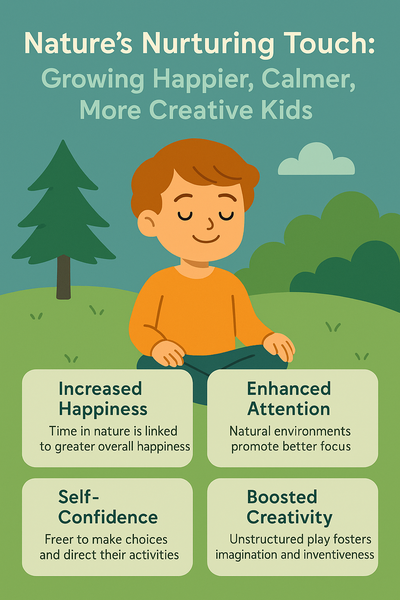
- B. Nature's Nurturing Touch: Growing Happier, Calmer, More Creative Kids
There's an undeniable magic that happens when children connect with the natural world. Research consistently shows that kids who spend ample time in nature tend to be happier, exhibit better attention spans, and experience less anxiety than their predominantly indoor counterparts. Nature acts as a gentle nurturer, building confidence in a unique way. Because outdoor play in natural settings is often less structured, children have the freedom to direct their own activities, manage their actions, and make independent choices, all of which cultivate self-assurance.
Unlike many indoor environments or the focused stimulation of a video game, nature engages multiple senses simultaneously and richly. Children can see the intricate patterns on a leaf, hear the symphony of bird songs, smell the earthy scent of damp soil, and feel the varied textures of bark and stone. This multi-sensory engagement is profoundly enriching. The unstructured character of play within nature is a fertile ground for creativity and imagination. Children interact meaningfully with their surroundings, designing their own games, approaching the world with inventive solutions, and thinking with a freedom that structured environments might not always permit. (Discover how to foster creativity in children). This natural laboratory also encourages critical thinking; the inherent wonder of the natural world prompts a cascade of questions about the Earth, its ecosystems, and the life it supports, sparking a desire to explore and understand.
An interesting aspect of nature's impact on the brain is the concept of "soft fascination." Natural environments often capture attention in an effortless way, allowing the mind to wander and reflect without demanding intense focus. This soft fascination is thought to help restore mental fatigue accumulated from activities requiring "directed attention," such as schoolwork or navigating busy urban settings. The implication is that breaks in nature are not just relaxing but can actively recharge a child's cognitive resources, potentially leading to improved concentration and learning capacity when they return to more demanding tasks. This positions nature exposure as a valuable component of a child’s routine, supporting academic performance and reducing stress associated with cognitive demands.
Beyond cognitive benefits, engagement with nature can lay a profound foundation for environmental stewardship. The "sense of wonder" that nature inspires, coupled with hands-on experiences like caring for a plant, can instill a deep-seated sense of responsibility towards the living world. When children ask questions about the earth and are entrusted with the care of its elements, they begin to understand their connection to it. These early positive experiences can cultivate a lifelong respect and a proactive desire to protect the natural environment, a significant long-term societal benefit rooted in the simple act of childhood play.
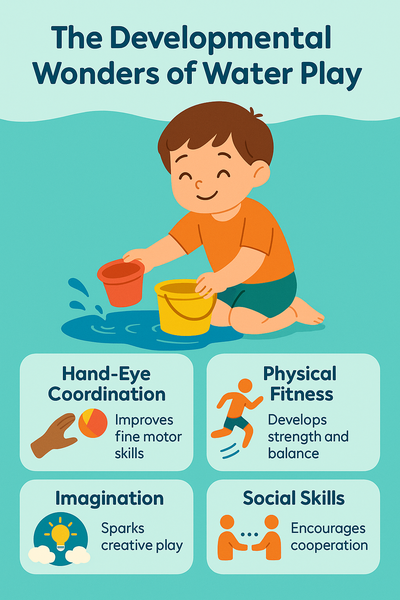
- C. Making a Splash: The Developmental Wonders of Water Play
The allure of water is almost universal for children, and for good reason. Water play is far more than just a way to cool off on a hot day; it's a developmental powerhouse. For many children, the sensory experience of water is wonderfully calming and therapeutic. The gentle touch, the repetitive motions of scooping or pouring, can help a child relax, unwind, and even improve their concentration. Of course, lively splashing and energetic water games also provide a fantastic outlet for pent-up energy and pure joy.
Physically, water play offers significant advantages. Activities like scooping, swooshing, squeezing, and pouring are excellent for developing hand-eye coordination and refining the fine motor skills crucial for everyday tasks such as writing, using cutlery, and dressing independently. When water play becomes more vigorous – running through sprinklers, dodging sprays, or carrying buckets – it transforms into a great physical workout, helping to develop gross motor skills, core strength, and balance.
The marvellous versatility of water is a natural stimulant for imagination and creativity. A simple tub of water can become a vast ocean for pirate ships, a stormy sea for mythical creatures, or a tranquil pond for floating leaf-boats. Cognitively, water play is an intrinsic learning experience. Without realizing it, children absorb fundamental concepts of science – observing water properties, changes in state (like ice melting), temperature differences, and what makes objects float or sink. They experiment with how water travels, how it can move other objects, and the effects of gravity. Mathematical concepts also come into play as they explore volume, measure quantity, and learn about ideas like 'more or less,' 'empty or full,' and 'cause and effect'.
Language and communication skills blossom during water play too. Children encounter and use a host of new vocabulary related to water and its actions – words like 'splash,' 'drizzle,' 'flow,' 'absorb,' and 'dissolve.' Social interaction often involves narrating their play, discussing ideas, and listening to others, which helps build sentence structure and conversational skills. This naturally leads to social and emotional development. Playing together with water encourages children to share resources and ideas, take turns, cooperate, and learn from observing their peers. These interactions are vital for building friendships and creating happy, lasting memories.
The unique power of water play lies in its capacity to simultaneously engage multiple senses and diverse developmental domains – physical, cognitive, social-emotional – in an organic, child-led fashion. It functions as a natural, playful laboratory where complex ideas like buoyancy or volume become tangible and understandable through direct, hands-on experience. This makes water play an exceptionally efficient and deeply engaging learning tool. Furthermore, the calming and therapeutic qualities of water suggest its value extends beyond simple recreation. For children who experience stress, anxiety, or sensory sensitivities, water play can serve as a valuable regulatory tool, helping them to unwind and find focus. Parents and educators can strategically use water-based activities not just for fun, but as a proactive means of supporting emotional well-being and sensory integration.
Section 2: Dive In! The Best Summer Activities for Young Explorers
With a deeper appreciation for why nature, water, and play are so vital, let's explore what exciting adventures await. Here’s a collection of ideas to spark imagination and get your young explorers moving, learning, and laughing all summer long. (For more summer childcare tips, check out our blog).
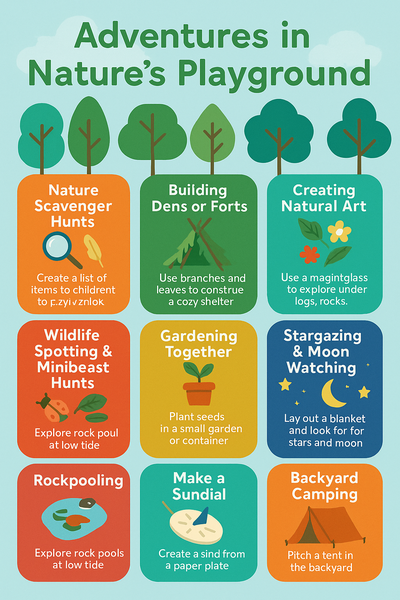
- A. Adventures in Nature's Playground The natural world is the ultimate playground, offering endless opportunities for discovery and fun with minimal equipment.
- Nature Scavenger Hunts: A fantastic way to sharpen observation skills.
- Create lists of items for children to find, such as a smooth pebble, a feather, a leaf with five points, something yellow, or an item the wind can blow.
- Themes can add an extra layer of fun – try a color hunt, a texture hunt (find something rough, smooth, bumpy), or even a sound hunt (listen for a bird, a buzzing bee, rustling leaves).
- Materials: A list (can be pictorial for pre-readers), a small bag or basket for treasures.
- Building Dens or Forts: A classic childhood adventure that fosters teamwork and creativity.
- Use fallen branches, large sticks, leaves, and any other natural materials you can find to construct a cozy shelter or a secret hideout in your backyard or a local woodland.
- Materials: Whatever nature provides! Ensure you only use fallen materials and respect living plants.
- Creating Natural Art: Let nature be the art supply store. (Explore eco-friendly crafts for kids for more ideas).
- Collect fallen leaves, colorful petals, interesting twigs, smooth stones, and vibrant flowers to create beautiful collages, sculptures, or temporary patterns on the ground. Make funny faces on the forest floor or arrange items into a mandala.
- Materials: Found natural items. Optionally, bring paper and child-safe glue if you want to make more permanent creations to take home.
- Wildlife Spotting & Minibeast Hunts: Become nature detectives.
- Equip your child with a magnifying glass and gently explore under logs, rocks, or in leaf litter to discover the fascinating world of insects and other small creatures.
- Consider making a simple pitfall trap (a yogurt pot buried to its rim) to see what crawls in overnight, or a footprint tunnel to identify nocturnal visitors.
- Materials: Magnifying glass, a small container or bug pot for temporary observation (ensure it has air holes and release creatures back where you found them), optional insect ID guide or app.
- Gardening Together: A rewarding way to learn about life cycles and responsibility.
- Give children their own small patch of garden or a container to plant seeds. Sunflowers, radishes, peas, and strawberries are often quick to grow and satisfying for little ones.
- Involve them in watering, weeding, and observing the plants as they grow.
- Materials: Seeds or young plants, soil, small child-sized gardening tools, a watering can.
- Stargazing & Moon Watching: Explore the night sky.
- On a clear evening, lay out a blanket in the backyard or a dark park (away from city lights if possible) and look up at the stars and moon.
- Try to spot constellations or watch for meteor showers – the Perseids in August are a reliable favorite.
- Materials: A comfortable blanket, optional: a star chart, binoculars, or a stargazing app.
- Rockpooling (if near the coast): Discover the hidden life of the seashore.
- At low tide, carefully explore rock pools to find small fish, crabs, anemones, and other marine creatures. Remember to treat the habitat and its inhabitants with respect.
- Materials: A bucket (for temporary observation, fill with seawater), a small net (use gently), sturdy waterproof shoes with good grip.
- Pressing Flowers and Leaves: Preserve nature's beauty.
- Collect interesting flowers and leaves (responsibly, without picking rare or protected species).
- Press them between sheets of newspaper inside a heavy book for a few weeks until they are dry and flat.
- Use the pressed items to decorate cards, create bookmarks, or make placemats by sealing them with clear contact paper.
- Materials: Flowers and leaves, newspaper, a heavy book. Optional: clear contact paper, cardstock for crafts.
- Make a Sundial: A simple and fascinating science experiment.
- Use a paper plate or draw a circle on a piece of cardboard. Place a pencil or stick upright in the very center.
- Take it to a sunny, level spot and mark where the shadow falls, noting the time. Return at hourly intervals to mark new shadow lines and times.
- Materials: Paper plate or cardboard, a straight pencil or stick, tape or modeling clay to hold the stick upright, a sunny spot, a way to tell time.
- Backyard Camping: An adventure close to home.
- Set up a tent in the backyard for an overnight stay or even just for daytime "camping" fun, complete with a picnic and outdoor games, which is great for younger toddlers.
- Materials: Tent, sleeping bags or blankets, flashlight, picnic supplies.
- Many of these seemingly simple nature activities serve as engaging gateways to STEM (Science, Technology, Engineering, and Math) learning. When children hunt for minibeasts, they are practicing observation and classification (biology). Crafting a sundial is a direct interaction with astronomy and the physics of light. Observing a tree through the changing seasons teaches about life cycles and environmental science , while exploring how seeds are dispersed is botany in action. This means parents can nurture an early interest in STEM fields without specialized kits or formal lessons, simply by guiding observation and encouraging questions during these everyday explorations. Moreover, the beauty of nature play is its remarkable adaptability. These activities can be enjoyed in diverse environments – from a sprawling woodland to a tiny backyard, or even the cracks in a sidewalk. Many require no special equipment, utilizing only what nature freely provides, such as materials for natural art. They can be easily simplified for toddlers or made more challenging for older children, making nature-based enrichment accessible to nearly all families and countering the notion that it necessitates elaborate trips or expensive gear.
- Nature Scavenger Hunts: A fantastic way to sharpen observation skills.
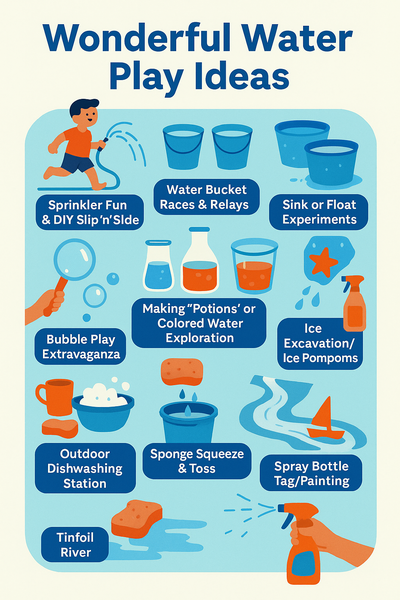
- B. Wonderful Water Play Ideas Water offers a unique sensory experience and endless possibilities for fun and learning, especially on warm summer days.
- Sprinkler Fun & DIY Slip 'n' Slide: Classic cool-downs.
- Let children run through a sprinkler or, for extra excitement, create a DIY slip 'n' slide using a sturdy plastic tablecloth pinned securely to a gentle slope in the lawn. Always ensure the landing area is clear and soft.
- Materials: Sprinkler and hose, or a heavy-duty plastic tablecloth and tent stakes.
- Water Bucket Races & Relays: A fun game for groups.
- Divide into teams. Each team member gets a bucket or large cup.
- Start each team with one full bucket of water. Players race to carefully pour the water into the next person's empty bucket, trying to spill as little as possible. The team with the most water at the end wins.
- Materials: Several buckets or large plastic cups per team.
- Sink or Float Experiments: A playful introduction to physics.
- Gather a collection of small, waterproof objects from around the house and garden (e.g., leaves, twigs, stones, plastic toys, coins, corks).
- Have children predict whether each item will sink or float before dropping it into a tub of water. Discuss why they think some things float and others sink.
- Materials: A large tub or basin of water, a variety of small objects to test.
- Bubble Play Extravaganza: Universally loved by children.
- Make your own bubble solution (dish soap, water, and a little glycerin or corn syrup can work well) or use a store-bought mix.
- Experiment with different bubble wands – try wire coat hangers bent into shapes, straws bundled together, or even a hula hoop for making giant bubbles.
- Materials: Bubble solution (homemade or store-bought), various items to use as wands.
- Making "Potions" or Colored Water Exploration: Unleash their inner scientist or wizard.
- Provide various containers (jugs, bowls, cups), water, and perhaps some child-safe food coloring.
- Let children mix colors, add natural items like flower petals or leaves, and pour their concoctions from one container to another. Pipettes or droppers add an element of fine motor practice.
- Materials: A selection of plastic containers, water, optional: food coloring, pipettes/droppers, natural items like petals and leaves.
- Ice Excavation/Ice Pompoms: A cool sensory and problem-solving activity.
- Freeze small toys, colorful pom-poms, or natural treasures like small shells or leaves inside ice cube trays or larger ice blocks.
- Provide children with safe "tools" to excavate their treasures, such as spray bottles filled with warm water, salt to sprinkle on the ice (which lowers its melting point), or blunt plastic tools for chipping away (with supervision).
- Materials: Ice cube trays or larger molds, small waterproof items to freeze, water. For excavation: spray bottles, salt (optional), child-safe blunt tools.
- Outdoor Dishwashing Station: Practical life skills meet messy fun.
- Set up a large bin with warm, soapy water, some sponges or cloths, and a collection of play dishes, plastic cups, or even some sturdy real kitchen items.
- Children love the bubbles and the satisfaction of "washing up". Provide a drying rack or towel for the clean items.
- Materials: Large bin or tub, kid-friendly dish soap, sponges or washcloths, plastic dishes/toys to wash, optional: a small drying rack.
- Sponge Squeeze & Toss: Simple, versatile, and great for motor skills.
- Use large, absorbent sponges. Children can practice squeezing water from one container to another, or you can paint targets on a wall or pavement for a "Sponge Bulls-Eye" game.
- Alternatively, cut sponges into strips, tie them together with rubber bands to form a ball shape, soak them in water, and have a gentle sponge toss.
- Materials: Large sponges, buckets. Optional: non-toxic paint for targets, rubber bands.
- Tinfoil River: Engineering a waterway.
- Unroll a length of tinfoil, shaping it into a long channel with raised sides. Angle it slightly downwards on a slope.
- Let children float small toy boats, rubber duckies, or natural items like leaves down their "river". They can experiment with the flow by changing the angle or adding "dams."
- Materials: A roll of heavy-duty tinfoil, small lightweight floating toys.
- Spray Bottle Tag/Painting: Cool and creative.
- Fill inexpensive spray bottles with water for a gentle and refreshing game of tag – you're "out" when your shirt is wet!
- Children can also use spray bottles to "paint" on outdoor surfaces like walls, fences, or patios; the water marks will disappear as they dry. For team tag, add a drop of different food coloring to each team's water (use old white t-shirts for this!).
- Materials: Spray bottles, water. Optional: food coloring and old t-shirts for team tag.
- Activities such as "Sink or Float" , "Ice Excavation" , and even observing how water behaves when sprayed from different types of bottles are, at their core, hands-on science experiments. These playful investigations encourage children to form hypotheses, make observations, and begin to understand fundamental physical properties like buoyancy, states of matter, and pressure. This makes water play a powerful, engaging, and unintimidating introduction to scientific thinking. Furthermore, a significant advantage of water play is its accessibility. Many highly enjoyable and developmentally rich activities can be set up using readily available household items such as buckets, sponges, tinfoil, and empty plastic bottles. This minimal need for specialized or expensive toys means that the profound benefits of water play are not exclusive to families with extensive resources, thereby promoting greater equity in early learning opportunities.
- Sprinkler Fun & DIY Slip 'n' Slide: Classic cool-downs.
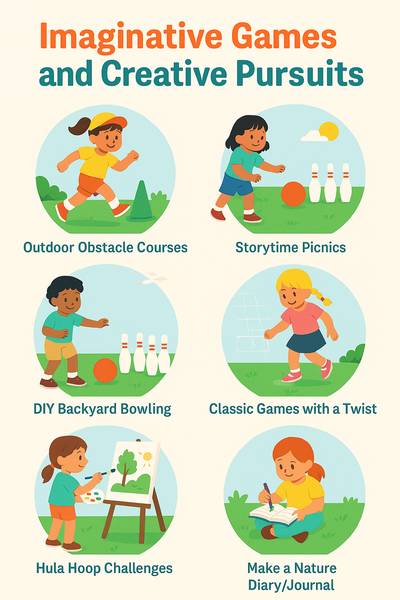
- C. Imaginative Games and Creative Pursuits (General Outdoor Play) Beyond specific nature or water themes, the great outdoors provides a perfect stage for all sorts of imaginative games and creative endeavors. (Find more fun brain-boosting activities for every age).
- Outdoor Obstacle Courses: A fantastic way to boost gross motor skills and problem-solving.
- Use everyday household items like chairs to crawl under, ropes to step over, hula hoops to jump into, pillows to leap onto, or pool noodles to weave through.
- Let children help design the course for an extra layer of engagement.
- Materials: Cones or markers, ropes, hula hoops, cushions, tunnels, jump ropes – whatever you have on hand!
- Storytime Picnics: Combine the joy of reading with the pleasure of being outdoors.
- Pack some yummy snacks, a cozy blanket, and a selection of your child's favorite books.
- Head to a local park, your backyard, or even just a shady spot under a tree for an alfresco reading session.
- Materials: Picnic blanket, snacks, drinks, books.
- DIY Backyard Bowling: Simple to set up and lots of fun.
- Use empty plastic bottles or cans as pins.
- Let children take turns rolling a lightweight ball to knock them down. They can keep score or just play for fun.
- Materials: 6-10 empty plastic bottles or cans (add a little sand or water for stability if needed), a medium-sized lightweight ball.
- Classic Games with a Twist: Timeless games that build skills and create laughter.
- Engage in energetic games of Tag or Hide-and-Seek (try "Sardines," where everyone who finds the hider joins them in the hiding spot until only one seeker is left).
- Play Red Light, Green Light to practice listening and reaction skills, or Simon Says to test following instructions.
- Draw a Hopscotch grid with chalk and find a small stone or beanbag to toss.
- Materials: Optional: chalk for hopscotch, a beanbag or small stone.
- Hula Hoop Challenges: More than just waist-hooping.
- See who can keep the hula hoop spinning around their waist, arm, or leg the longest.
- Use hoops as targets to roll balls into, as rings to jump in and out of during an obstacle course, or even as "steering wheels" for imaginative play.
- Materials: Hula hoops.
- Outdoor Art Station: Take creativity outside. (Creative activities can also boost children's mental health).
- Beyond using natural materials, set up an easel with large paper, or tape paper to a fence or wall.
- Provide washable paints, crayons, or chalk and let children paint or draw what they see around them – the landscape, flowers, insects ("en plein air" style).
- Materials: Large paper or old sheets, washable paints, brushes, sponges, crayons, chalk, easel (optional).
- Make a Nature Diary/Journal: A wonderful way to document summer adventures. (This is a great way to keep kids engaged and learning during summer break).
- Encourage children to keep a special notebook where they can record their outdoor discoveries and experiences.
- They can draw pictures of plants and animals they've seen, write short stories inspired by their adventures, paste in photos, or press flowers and leaves directly onto the pages.
- Materials: A blank notebook or scrapbook, pens, pencils, crayons. Optional: camera, glue, stickers.
- Many of these engaging outdoor games serve as powerful tools for developing crucial executive function skills – the mental processes that enable us to plan, focus attention, remember instructions, and juggle multiple tasks successfully. For instance, creating and navigating an obstacle course involves planning and sequencing actions. Games like "Simon Says" demand inhibitory control (acting only when the correct phrase is used) and working memory (holding the rule in mind). Similarly, "Red Light, Green Light" hones response inhibition and sustained attention. Even strategic games like "Capture the Flag" require planning, teamwork, and adapting to changing situations. Thus, these "fun games" are actually robust brain-training activities, building a foundation of skills essential for academic achievement and effective life management. Moreover, the enduring appeal and developmental impact of classic, low-tech games like tag and hide-and-seek highlight an important truth: children often thrive on simple, imaginative, and peer-driven activities. These can be more enriching than passive, adult-directed entertainment or screen-based options. The fact that these games typically require minimal materials and rely heavily on children's own creativity and rule-making suggests that sometimes, over-scheduling or over-resourcing children's playtime might inadvertently stifle the very intrinsic motivation and imaginative spark we wish to foster.
- Outdoor Obstacle Courses: A fantastic way to boost gross motor skills and problem-solving.
Section 3: Playing it Safe: Essential Summer Safety for Happy Adventures
Summer adventures are all about fun, but ensuring those adventures are safe is paramount. A few key precautions can help prevent common summer mishaps and keep the focus on creating positive memories. (Explore our safety blog category for more tips).
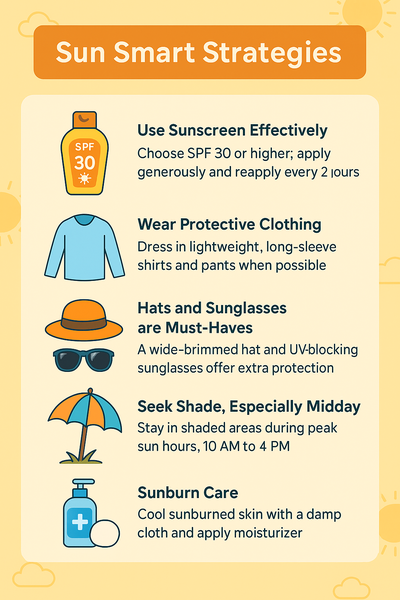
- A. Sun Smart Strategies Protecting delicate skin from the sun's powerful rays is a top priority. (Learn more about sun safety for kids).
- Use Sunscreen Effectively:
- Choose a broad-spectrum sunscreen that protects against both UVA and UVB rays, with an SPF (Sun Protection Factor) of 30 or higher.
- Apply sunscreen generously to all exposed skin about 20 to 30 minutes before going out into the sun, allowing it time to absorb properly.
- Reapply sunscreen every two hours, and more frequently if children are swimming or sweating heavily. Don't forget often-missed spots like the tops of ears, back of the neck, and tops of feet.
- Wear Protective Clothing:
- Whenever practical, dress children in lightweight, loose-fitting clothing that covers their arms and legs.
- Look for sun-protective clothing with a UPF (Ultraviolet Protection Factor) rating for an added layer of defense.
- Hats and Sunglasses are Must-Haves:
- A wide-brimmed hat (with a brim of at least 3 inches) provides excellent protection for the face, ears, and neck.
- Protect children's eyes with sunglasses that block 99% to 100% of UVA and UVB rays (look for a UV 400 rating).
- Seek Shade, Especially Midday:
- The sun's rays are strongest between 10 AM and 4 PM. During these peak hours, try to plan indoor activities or ensure children play in well-shaded areas.
- If you're at a park or beach, set up under a tree, umbrella, or canopy.
- Sunburn Care:
- If a mild sunburn does occur, cool the skin with cool compresses or a gentle bath. Apply a soothing, hypoallergenic moisturizing lotion. Keep the child well-hydrated.
- Instilling these comprehensive sun safety practices from an early age does more than just prevent the discomfort of a summer sunburn. It plays a crucial role in reducing the long-term risk of skin cancer and other sun-related skin damage. Childhood is a formative period for establishing lifelong habits. When parents consistently model and enforce sun safety rules – applying sunscreen, wearing hats, seeking shade – these behaviors become normalized for children. In essence, parents are not only protecting their children in the immediate moment but are also acting as vital health educators, instilling preventative behaviors that will benefit their children for decades to come.
- Use Sunscreen Effectively:
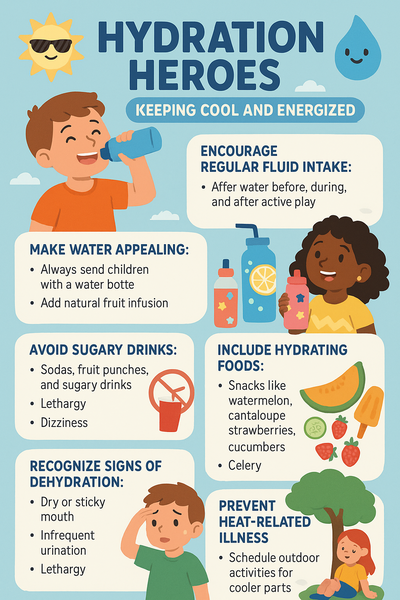
- B. Hydration Heroes: Keeping Cool and Energized Active kids in the summer heat need to stay well-hydrated to keep their energy levels up and their bodies functioning optimally. (Discover hydration tricks for kids).
- Encourage Regular Fluid Intake:
- Children should drink plenty of fluids, primarily water, throughout the day. Don't wait for them to say they're thirsty, as they may already be slightly dehydrated by then.
- Offer water before, during, and after active play.
- Make Water Appealing:
- Always send children to camp, the park, or even just the backyard with a water bottle.
- To make water more enticing, try adding natural fruit infusers like slices of lemon, lime, cucumber, berries, or melon. Fun cups, silly straws, or letting children decorate their own water bottles with stickers can also encourage them to drink more.
- Avoid Sugary Drinks:
- Sodas, fruit punches, and other sugary drinks can actually contribute to dehydration and offer little nutritional value. Stick to water or, occasionally, diluted fruit juices.
- Include Hydrating Foods:
- Many fruits and vegetables have high water content and can contribute to overall hydration. Offer snacks like watermelon, cantaloupe, strawberries, cucumbers, celery, and tomatoes. Homemade fruit popsicles are also a great hydrating treat. (Find colorful rainbow recipes kids will love).
- Recognize Signs of Dehydration:
- Be aware of early signs of dehydration, which can include a dry or sticky mouth, infrequent urination or dark yellow urine, lethargy, dizziness, or a lack of tears when crying. Address these signs immediately by offering fluids and moving to a cooler environment.
- Prevent Heat-Related Illness: (Learn how to spot heat exhaustion symptoms in kids).
- Schedule strenuous outdoor activities for cooler parts of the day (early morning or late afternoon/evening).
- Ensure children take frequent rest breaks in cool, shaded places.
- Avoid being outdoors in direct sunlight during extreme heat, especially if temperatures are above 95°F (35°C).
- Crucially, never leave infants or children unattended in a parked car, even for a minute, as temperatures inside a vehicle can rise to dangerous levels very quickly.
- While the primary focus of hydration advice is often on preventing serious heat-related illnesses like heat exhaustion or heatstroke, it's important to recognize that even mild dehydration can impact a child's overall well-being and enjoyment of summer activities. Adequate hydration is crucial for maintaining cognitive function, concentration, and mood. When children are properly hydrated, they are more alert, have better focus, and are generally happier, all of which significantly enhance their ability to learn, play, and interact positively throughout their summer adventures.
- Encourage Regular Fluid Intake:
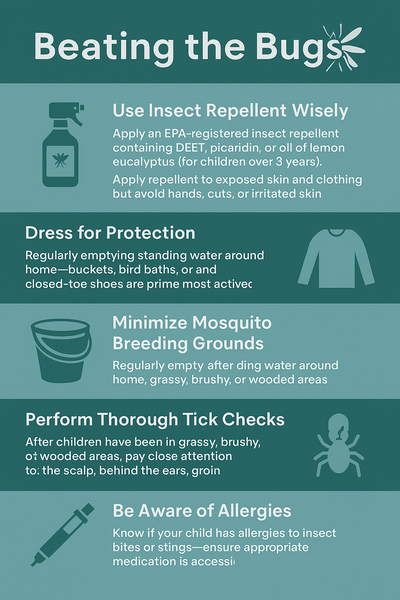
- C. Beating the Bugs Mosquitoes, ticks, and other biting insects can quickly turn outdoor fun into an itchy ordeal. A few preventative measures can help.
- Use Insect Repellent Wisely:
- Apply an EPA-registered insect repellent suitable for children. Products containing DEET, picaridin, or oil of lemon eucalyptus (for children over 3 years) are effective. Always follow product label instructions regarding age appropriateness and application.
- Apply repellent to exposed skin and clothing, but avoid hands (as children may put them in their mouths/eyes), cuts, or irritated skin.
- Be especially vigilant around dusk and dawn when mosquitoes are often most active, and in wooded or grassy areas where ticks are prevalent.
- Dress for Protection:
- When playing in areas known for ticks or mosquitoes, encourage children to wear long-sleeved shirts, long pants, and closed-toe shoes with socks.
- Tucking pant legs into socks can provide extra protection against ticks.
- Light-colored clothing can make it easier to spot ticks before they attach.
- Minimize Mosquito Breeding Grounds:
- Regularly empty any standing water from around your home – in buckets, bird baths, old tires, or plant saucers – as these are prime breeding spots for mosquitoes.
- Perform Thorough Tick Checks:
- After children have been playing in grassy, brushy, or wooded areas, conduct a careful tick check. Pay close attention to the scalp, behind the ears, in the armpits, around the groin, behind the knees, and between the toes.
- If you find a tick, remove it promptly and correctly using fine-tipped tweezers. Grasp the tick as close to the skin's surface as possible and pull upward with steady, even pressure. After removing the tick, thoroughly clean the bite area and your hands with rubbing alcohol or soap and water.
- Be Aware of Allergies:
- Know if your child has any allergies to insect bites or stings.
- If so, ensure you have appropriate medication, such as antihistamines for mild reactions or a prescribed epinephrine auto-injector for severe allergies, readily accessible, and know how to use it. (It's always good to know first aid fundamentals).
- Effective insect protection is about more than just avoiding discomfort or itchy bites; it's a key factor in enabling children to safely access and fully enjoy the diverse natural environments that offer so many developmental benefits. The fear of mosquito-borne illnesses or tick encounters can understandably make parents hesitant to let their children explore woods, fields, and gardens. However, these are precisely the kinds of settings rich in opportunities for learning, discovery, and the type of holistic development discussed earlier. By implementing practical and effective insect safety measures, parents can feel more confident in allowing their children the freedom to engage with these valuable outdoor spaces, thereby unlocking the broader spectrum of benefits that nature play offers.
- Use Insect Repellent Wisely:

- D. Water Wisdom: Key Safety Rules for Water Activities Water play is a summer highlight, but safety must always come first. Drowning is a leading cause of accidental death for young children, but it is preventable.
- Constant, Undistracted Supervision is Non-Negotiable:
- This is the most critical layer of protection. A responsible adult, designated as the "Water Watcher," must actively supervise children whenever they are in or near any water – pools, lakes, oceans, bathtubs, or even buckets of water.
- This means avoiding all distractions, including cell phones, conversations, or reading.
- For young children and inexperienced swimmers, "touch supervision" is essential – the supervising adult should be within arm's reach at all times.
- Everyone Learns to Swim & Achieves Water Competency:
- Enroll children in age-appropriate swim lessons from a qualified instructor. Basic swimming skills and water safety knowledge are vital.
- Water competency goes beyond just swimming; it includes being able to enter the water, get a breath, stay afloat, change position, swim a distance, and then exit the water safely.
- Use U.S. Coast Guard-Approved Life Jackets:
- Young children, inexperienced swimmers, and everyone participating in boating, kayaking, paddleboarding, or other open water activities should wear a properly fitted U.S. Coast Guard-approved life jacket.
- Do not rely on inflatable toys like water wings, noodles, or rafts as safety devices; they are not substitutes for life jackets or proper supervision.
- Secure Home Pools and Spas:
- If you have a home pool or spa, install multiple layers of protection. This includes four-sided isolation fencing (at least 4 feet high) that completely separates the pool area from the house and yard, with self-closing and self-latching gates that are out of a child's reach.
- Remove ladders or steps for above-ground pools when not in use. Consider pool alarms or safety covers as additional barriers.
- Safety at Splash Pads and with Sprinklers:
- Even without standing water, supervision is key. Ensure the water is properly treated if it's recirculated.
- Teach children not to swallow the water or sit/stand directly on water jets (which can introduce contaminants).
- Water shoes can help prevent slips on wet surfaces and protect feet. Enforce a "no running" rule.
- Beach Safety Savvy:
- Whenever possible, swim only at beaches supervised by lifeguards.
- Pay attention to posted warnings about water quality, rip currents, or dangerous shorebreak.
- Before settling down, scan the sand for hazards like sharp objects or jellyfish.
- If children dig holes in the sand, ensure they are never deeper than the child's own knee height, as sand can collapse and cause suffocation. Always fill in holes before leaving the beach.
- Teach children to always face the water so they can see incoming waves, and to enter the water feet first to gauge depth and temperature.
- Always use the buddy system – no one swims alone.
- Lake and River Safety Smarts:
- Enter unknown or shallow water feet first, never dive headfirst.
- Be aware of potential hazards like sudden drop-offs, underwater currents, cold water temperatures (even on hot days), and submerged objects or vegetation.
- Stay close to shore, especially if the water is cold or swimmers are inexperienced. Obey all posted safety signs and warnings.
- Emergency Preparedness is Key:
- Learn CPR and basic water rescue skills. Seconds count in a water emergency.
- Keep a phone readily accessible to call 911 or local emergency services if needed.
- If a child is missing, always check the water first.
- Teach children to always ask permission from an adult before going near or into any water.
- Effective water safety is not about relying on a single preventative measure but rather embracing a philosophy of "layers of protection". This approach recognizes that any individual safety strategy (like supervision alone, or a child knowing how to swim) can sometimes fail. By implementing multiple, overlapping safeguards – such as constant supervision, physical barriers like fences, proper use of life jackets, ensuring everyone learns to swim, and being prepared for emergencies – the overall risk of drowning is significantly reduced. This represents a crucial shift in mindset from seeking single-point solutions to establishing a comprehensive, systemic approach to safety around water. Furthermore, while general principles like vigilant supervision are universally applicable, the specific dangers inherent in different aquatic environments vary considerably. A home swimming pool presents different risks (like unfettered access or drain entrapment) than a public splash pad (water quality, slippery surfaces), a beach (rip currents, wave action, sand holes), or a lake (cold water, currents, submerged hazards). This underscores the need for parents to adopt tailored safety responses appropriate to each specific environment, requiring a more nuanced understanding and proactive preparation beyond general water safety guidelines.
- Constant, Undistracted Supervision is Non-Negotiable:
Section 4: Nurturing Curiosity: Fostering Child-Led Exploration This Summer
Beyond planning specific activities, summer is a wonderful time to nurture your child's innate curiosity and encourage them to lead their own explorations. Creating an environment that invites discovery can be just as valuable as any structured game. (Find more parents tips on our blog).
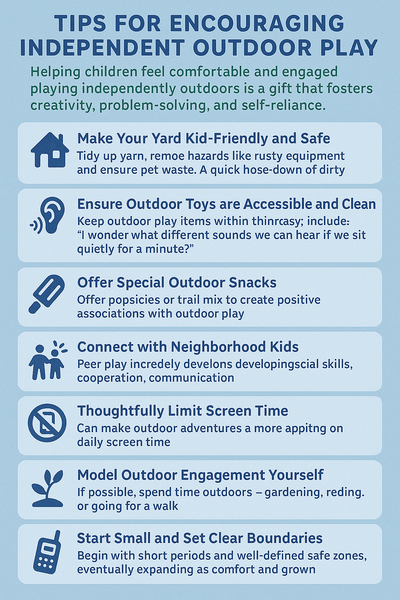
- A. Tips for Encouraging Independent Outdoor Play Helping children feel comfortable and engaged playing independently outdoors is a gift that fosters creativity, problem-solving, and self-reliance.
- Make Your Yard Kid-Friendly and Safe:
- Take some time to tidy up your outdoor space. Remove any potential hazards like rusty old play equipment, check for wasp nests, and ensure pet waste is cleared. A safe and inviting yard gives parents peace of mind and children the freedom to explore without constant intervention.
- Ensure Outdoor Toys are Accessible and Clean:
- Keep balls, sidewalk chalk, jump ropes, scooters, bikes, and other outdoor play items in a place where children can easily see and reach them. If toys are buried in the garage or dirty, they're less likely to be used. A quick hose-down of plastic play sets can make them much more appealing.
- Use "I Wonder" Prompts to Spark Curiosity:
- Instead of directing play, try posing gentle, open-ended questions. Phrases like, "I wonder if there are any interesting insects living under that big leaf?" or "I wonder what different sounds we can hear if we sit quietly for a minute?" are hard for a child's curious mind to resist and can lead to delightful, self-directed adventures.
- Offer Special Outdoor Snacks:
- Occasionally surprising your child with a fun, easy-to-eat snack while they're playing outside can create positive associations with independent outdoor time. Think popsicles on a hot day or a small bag of trail mix.
- Connect with Neighborhood Kids:
- If possible, facilitate opportunities for your child to play outdoors with other children in the neighborhood. Peer play is incredibly beneficial for developing social skills, cooperation, communication, and even executive functions. Sometimes, just being outside yourself can draw other kids out.
- Thoughtfully Limit Screen Time:
- It's well-established that excessive screen time can displace active, outdoor play. Consider setting clear limits on daily or weekly screen use to make outdoor adventures a more appealing option. (Navigate the screen time dilemma with our guide). When screens are less available, children are often more motivated to seek out other forms of engagement.
- Model Outdoor Engagement Yourself:
- Children often follow their parents' lead. If you spend time outdoors – whether it's gardening, reading a book on the patio, or going for a walk – your children are more likely to be drawn outside too. (Learn about how adult behavior shapes child development).
- Start Small and Set Clear Boundaries:
- If you or your child are new to independent outdoor play, start with short periods and clearly defined safe zones. As they demonstrate responsibility and confidence (and as you become more comfortable), you can gradually expand their freedom. Walkie-talkies can be a fun way to maintain a connection while allowing for more independent exploration.
- Many of these practical suggestions subtly address common parental anxieties surrounding independent play. Creating a physically safe yard, for instance, directly alleviates concerns about immediate dangers. The idea of parents being present outdoors, even if not directly involved in the child's play, can offer a comforting backdrop for both child and adult. Starting with small, bounded explorations allows parents to gradually build trust in their child's capabilities and in their own ability to grant that independence. This highlights that fostering independent play is often as much about parental growth – managing fears, trusting children's judgment – as it is about the child's development. Furthermore, strategies like making toys easily accessible, using "I wonder" prompts, or offering occasional outdoor treats function as gentle "invitations to play". They create an environment and a subtle nudge that encourages children to initiate their own activities, rather than waiting for adult direction. This approach respects the child's agency and is powerful in fostering intrinsic motivation and creativity, as children feel a sense of ownership over their play choices.
- Make Your Yard Kid-Friendly and Safe:

- B. Creating an Environment that Sparks Discovery The way an outdoor space is set up and the tools provided can significantly influence a child's inclination to explore and learn.
- Embrace Nature as the Ultimate Teacher:
- Recognize that the natural world is rich with learning opportunities. Allow children the freedom to interact with plants, observe animals (from a safe distance), feel the weather, and explore the textures and smells around them. There is so much to discover. (Explore steps to early education success).
- Go on Sensory Walks:
- Encourage children to consciously use all their senses as they move through an outdoor space. Prompt them to notice different colors, listen for distinct sounds, smell flowers or damp earth, feel the texture of bark or a smooth stone, and even (when safe and appropriate, like tasting a ripe berry from your own garden) explore taste. This can be a simple, mindful stroll or a more structured path with designated "sensory stations."
- Provide Simple Tools for Exploration:
- A few basic tools can greatly enhance child-led discovery without overly directing it. Consider items like a magnifying glass for examining tiny details, child-friendly binoculars for bird watching, a small bucket for collecting treasures, a net for gently catching (and releasing) insects or pond life, or a blank notebook and pencil for a nature journal.
- Incorporate Natural Materials into Play Spaces:
- If possible, use natural elements to define play areas. Logs can become benches or balance beams, large stones can outline a "fairy garden," and a pile of leaves can be an invitation for jumping or hiding. Encourage play with found items like leaves, twigs, pebbles, and flowers for art or imaginative games.
- Allow for (and Even Encourage) "Messy" Play:
- Some of the most valuable sensory and learning experiences come from activities that are a bit messy. Exploring mud, digging holes (in appropriate and safe locations), making mud pies, or mixing "potions" with water, soil, and leaves can be incredibly engaging and educational. Have old clothes and towels at the ready!
- Ask Open-Ended Questions:
- When your child makes a discovery or is engaged in an activity, resist the urge to immediately provide answers or explanations. Instead, ask open-ended questions that prompt further investigation, critical thinking, and their own theorizing. For example, "What do you think would happen if we added more water to that sand?" or "Why do you suppose that butterfly landed on that particular flower?"
- Fostering genuine child-led exploration often requires a subtle but significant shift in the adult's role: from being the primary director of activities or the main source of entertainment to becoming a thoughtful facilitator. This means preparing an inviting and stimulating environment, providing simple tools or materials that spark interest, and then stepping back to allow children the space and time to make their own discoveries. This approach empowers children, builds their confidence and problem-solving skills, and nurtures intrinsic motivation as they take ownership of their learning journey. It also involves valuing the process of discovery, experimentation, and even what might look like "failure" – a den that collapses, an experiment that doesn't go as planned – as much as, or even more than, a tangible end product or a "correct" answer. When children are free to explore without fear of getting it wrong, they learn resilience, adaptability, and the true joy of inquiry. This means parents and caregivers should celebrate the curiosity, effort, and learning that unfolds during the exploration itself, fostering a growth mindset that will serve children well in all areas of life.
- Embrace Nature as the Ultimate Teacher:
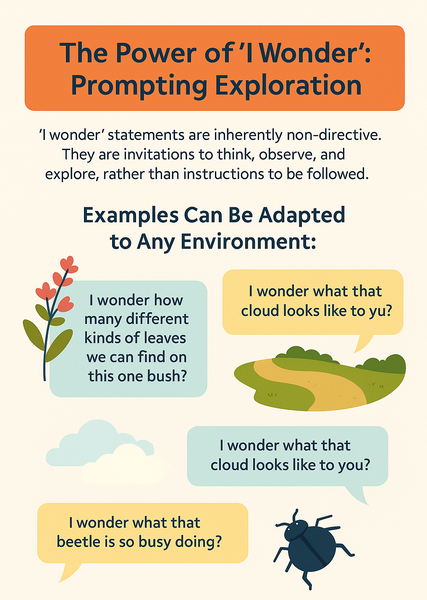
- C. The Power of "I Wonder": Prompting Exploration One of the simplest yet most effective tools for sparking child-led exploration is the strategic use of "I wonder..." statements. This gentle technique works by planting a seed of curiosity without imposing a task or expectation.
- "I wonder" statements are inherently non-directive. They are invitations to think, observe, and explore, rather than instructions to be followed.
- Examples can be adapted to any environment:
- In the garden: "I wonder how many different kinds of leaves we can find on this one bush?"
- On a walk: "I wonder where that little trail goes?"
- Looking at the sky: "I wonder what that cloud looks like to you?" or "I wonder why the sky is so blue today?"
- Observing an insect: "I wonder what that beetle is so busy doing?"
- The key is to then pause, listen attentively to your child's responses or observe their actions. If they pick up on the "wonder," follow their lead. Their ideas, questions, or investigations become the new path of discovery.
- When a parent or caregiver voices an "I wonder" prompt, it can beautifully initiate a shared journey of discovery. Because the phrase itself often implies that the adult doesn't necessarily have all the answers or is genuinely curious alongside the child, it positions the child as a capable co-explorer and thinker. This dynamic shifts away from a top-down impartation of knowledge towards a collaborative investigation, fostering not only curiosity and learning but also a stronger, more connected parent-child bond built around shared moments of wonder and exploration.
Section 5: Making Summer Memories: Embrace the Joy of Play
As the summer days stretch out before us, filled with warmth and light, the opportunities for connection and growth through nature, water, and play are boundless. These experiences offer far more than just a way to pass the time; they are fundamental to a child's healthy development, nurturing their physical skills, cognitive abilities, social-emotional well-being, and creative spirits.
The laughter shared while building a wobbly den, the quiet concentration of watching a ladybug crawl up a stem, the exhilarating splash of a cool sprinkler, the shared wonder of a starry night – these are the moments that weave the rich tapestry of childhood. They are the building blocks of confidence, resilience, and a lifelong love of learning and exploration. (Learn about cherishing life's little moments in parenting).
More than that, these shared adventures strengthen the invisible, invaluable threads that connect a family. The joy, the teamwork, the simple presence with one another during these playful times contribute profoundly to overall family well-being and create a positive emotional foundation that lasts far beyond the summer months. (Discover parenting hacks for building strong bonds). Prioritizing this kind of family play is truly an investment in the emotional health and cohesion of your family unit.
So, this summer, embrace the call of the outdoors. Encourage your children to get a little muddy, to ask big questions, to invent their own games, and to simply be. The memories you make and the growth you witness will be the sweetest rewards of all. (For more on healthy parenting, visit our blog).
Sources used in this blog :
The importance of outdoor play (and how to support it) | UNICEF ...
How play strengthens your child's mental health | UNICEF Parenting
The Benefits of Outdoor Play: Why It Matters | Children's Hospital of ...
Why Kids Need to Spend Time in Nature - Child Mind Institute
The Importance of Play in Early Childhood | Bright Horizons | Bright ...
The benefits of water play for children's development | St Nicholas ...
10 Ideas to Get You and Your Child Exploring Outdoors | NAEYC
Nature Activities for Kids and Families - Woodland Trust
36 Summer Outdoor Activities for Kids to Enjoy in Nature - Get the ...
Nature activities for summer | Natural History Museum
Playing With Water | PBS KIDS for Parents
8 Essential Summer Safety Tips for Kids: Keep Them Safe
Summer Safety Tips For The Whole Family | Patient Care
15 Outdoor Games for Kids: Perfect for Every Backyard! | Chomps
Fun Summer Activities for Kids and Toddlers - Hello Pediatrics
Swimming Safety | Swim Safe | American Red Cross
Water Safety | American Red Cross

Comments
No comments yet. Be the first to leave a comment!